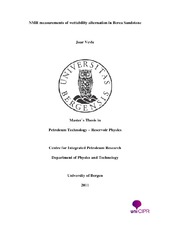| dc.description.abstract | When a new oil reservoir is discovered and a production strategy is chosen the knowledge about wettability characteristics for the field is of outermost importance. Wettability is a key factor for fluid distribution and fluid displacement. Many laboratory methods have therefore been developed and used over the years in order to measure wettability. Common to many of these methods are that they only give indirect information about wettability based on other parameters like imbibition rate, capillary pressures curves and relative permeability data. Displacement based methods are also often quite time consuming. In this thesis we will investigate the use of Nuclear Magnetic Resonance (NMR) as a tool to find wettability data for 3 different systems of oil and water. Because of the NMR techniques natural sensitivity to position and surface effects between pore fluid and pore surface in a porous media it is ideal for investigating the wettability of a rock. Because the wetting state of the rock will have a big impact on the fluid distribution both on the micro scale inside a single pore, and on a larger scale in the porous media, NMR is capable of giving an indication for the wetting state. In order to find sufficient information about the system, we applied specialized NMR sequences order to separate the signal from the two phases based on diffusion coefficient and by the effects from internal gradients. Specialized NMR sequences were also used find the correlation between transverse and longitudinal relaxation rate. When combining these sequences with standard CPMG experiments it increases the amount of information obtained from the porous media. We have chosen Berea sandstone as a basis for the experiments and will be looking at a system of crude oil in aged cores, mineral oil in non-aged cores and crude oil in non-aged cores. A reference system at 100% water saturation n was also investigated. Because the aging of the cores changes the wettability of the core, we believe that it is possible to detect this by the use of NMR and find how it differs from the non-aged cores. We will also include a traditional USBM/Amott test in order to correlate this to the NMR-response in each system. The cores that have been chosen to undergo ageing were flooded with crude oil at 110˚C for a period of 4 weeks. All of the cores have then been subjected to the combined USBM/Amott test to establish the wettability of each core. We found that the aged cores had changed significantly towards neutrally wet, and the non-aged cores were strongly water wet. In the NMR part of the experiment we found that when doing only a standard CPMG test of the cores the broadening of the peaks originating from each phase made it hard to separate the response from each phase. This made it difficult to use the CPMG data as a wettability indicator. Despite this we were able to find some indicators of a change in the aged cores. When comparing the T2 distribution from the aged and the non-aged core we found that there had been a reduction in the main peak and increase in intensity at shorter T2 values of the aged core`s T2 distribution. This is described as an effect of changed wettability state, where the altered wetting conditions cause the oil to come into contact with the pore... | en_US |
